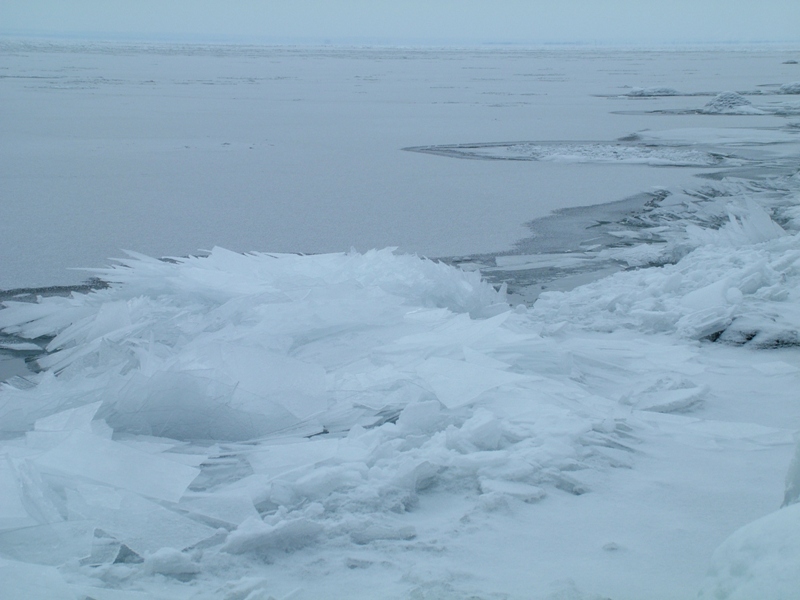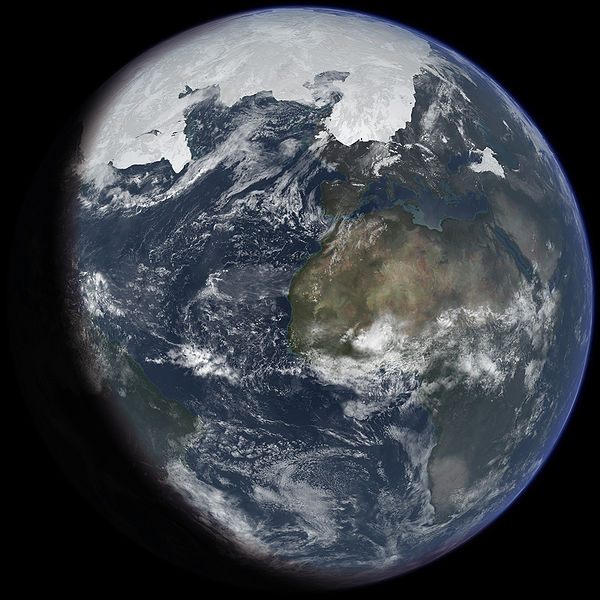Lake Superior Contains 10% of all of the Earth’s (non-frozen) freshwater. It is the largest freshwater lake on the planet, and is only 10,000 years old. Average summer temperature there is only 40ºF.
How did it form, and why is it so cold?
During the last ice age, the ice was 2km thick over the region. The moving ice carved and depressed the land, and when the ice melted the Superior Basin filled up with ice water. The water has warmed slowly over the last 10,000 years and still remains quite cold.
No doubt governments were very upset at the rapid rate of ice loss and sea level rise 10,000 years ago. Yet there really wasn’t anything they could do about it.
http://en.wikipedia.org/wiki/File:IceAgeEarth.jpg
Fortunately, we have returned to a milder climate where people don’t have to wear those thick Mastodon coats any more.





Peer reviewed study says current Arctic sea ice is more extensive than most of the past 9000 years
http://wattsupwiththat.com/2010/09/23/surprise-peer-reviewed-study-says-current-arctic-sea-ice-is-more-extensive-than-most-of-the-past-9000-years/
Hahahaha, Lake Superior is cold because its filled with still-cold glacial melt water? Yes, if you’re lucky while fishing on it, you can still spot some glacial ice cubes floating in the middle with mammoths still frozen in them! Hahahaha!! Too funny. Did I miss April Fool’s?
No, apparently you missed Junior High School earth science though.
So I was exaggerating on the mammoths! But still, you’re too funny Steven! Cold because of the glaciers – ha!
Matt,
The heat capacity of Lake Superior is huge. It is much colder than the other Great Lakes because it has not yet equilibrated with the post-glacial climate.
Right… so tell me Steven, what should the temperature of Lake Superior be? A balmy 80°F?
Consider this: the average annual temperature of the surrounding region is less than 40°F (i.e. its below that at least half the year), does it now make sense that Lake Superior doesn’t get much above that in the summer, especially given its large thermal mass, and extreme depths?
Most of the water is just above freezing – around 34-35F.
I’m not sure I believe the part where the cave girls look like Raquel Welch. But I’m good with the rest of it.
Here in the Northwest, we’re dotted with tiny glacial depressions that today are lakes big and small . The soil is glacial till. My home is built on it. Very stable, but don’t try to dig anywhere with only a shovel.
Greens worship the “natural” landscape as an untouchable shrine. But in fact, it’s a pile of useless waste and debris covered with a stand of weeds we call “forest”. I enjoy it as much as anyone, but it is what it is.
Lake Superior is a pup compared to what it replaced. Lake Agassiz was an immense glacial lake located in the center of North America. Fed by glacial runoff at the end of the last glacial period, its area was larger than all of the modern Great Lakes combined, and it held more water than contained by all lakes in the world today.
http://en.wikipedia.org/wiki/Lake_Agassiz
An interesting thing is occurring in North Dakota.
North Dakota lake swallows land and buildings. DEVILS LAKE, N.D. – It’s been called a slow-growing monster: a huge lake that has steadily expanded over the last 20 years, swallowing up thousands of acres, hundreds of buildings and at least two towns in its rising waters.
http://news.yahoo.com/s/ap/20100922/ap_on_re_us/us_monster_lake_3
Far out. As a geologist I love the story and in particular the cyclicity of the phenomina ……… hmmmm I wonder what else
will prove to by cyclical?
So, how would one know when Lake Superior achieved thermal equilibrium? Seems to be an interesting measurement/computation problem for some bright spark to go after on a cool winter’s evening.
Well, consider that the transit time for the oldest parts of the global thermohaline system is about 1600 years. That’s for cold water starting in the Arctic, travelling all the way south down the Atlantic, and then all the way north to well up in the north Pacific. That’s for the global ocean heat transit. A dimple like Lake Superior wouldn’t even come close.
What do you think would drive convection in Lake Superior?
From: http://www.seagrant.umn.edu/superior/processes
Stratification becomes more pronounced and deeper as Lake Superior’s surface warms to a September high. As the winter solstice approaches and the buoyant surface waters cool, the density between layers becomes increasingly similar. When the density is similar enough, a windstorm can mix the entire lake. This sinking of heavy water and mixing by wind results in the exchange of surface and bottom waters, an event referred to as lake turnover. Global climate patterns influence the timing of the lake’s turnover. Turnover is enormously important for redistributing nutrients and oxygen within the water column. The lake is thought to mix rather completely until the surface waters cool enough to show negative stratification, a condition in which positively frigid water (0-3.93°C) lies above very cold water. This period of stratification breaks down in June, after the returning sun has warmed the surface water back to 3.94°C and its maximum density 1.000 gm/ml. This is when spring turnover occurs.
Based on the above would appear that the lake mixes completely twice a year, spring and fall, (due to the fact that the density of water is greatest at a temperature of 3.93 degrees C and the surface waters pass through this point on the way up in the spring and on the way down in the fall.) In other words that real cold glacial water on the bottom was at the surface a few months earlier.
(I’m really curious to see how this discussion ends.)
Lake Superior is 400 metres deep and the bottom half is just above freezing (i.e. almost ice water.)
http://www.glerl.noaa.gov/res/glcfs/glcfs.php?lake=s&ext=wt2d&type=N&hr=00
It is pretty clear from the temperature profile that little mixing occurs below 150 metres depth.
So it is your position that the water at the bottom of the lake does not mix during the twice-yearly turnover; that it is cold glacial water that has rested there for nearly 10,000 years undisturbed, correct? And that, furthermore, the presence of that glacial melt water explains the cold temperature of Lake Superior?
I have to agree with Matt. Lake Superior is cold because it is in an area with a relatively low annual average temperature (39.4 F on the south-eastern coast where I live), it is deep so most of the water column is not affected by summer heating, and, perhaps a smaller influence, the large majority of the overland inflow is from cold water rivers and streams influenced by melting snow and cold ground water springs. Tempering this is the fact that a good portion of the lake ices over in the winter, and occasionally the entire lake does, which can help insulate from the not uncommon minus 40 in January.
It was not clear from the article that you were suggesting Superior is cold besause it comes from melted ice, but after reading your comments to Matt that seems to be the case. There must be some sort of calculation that could show the thermal capacity of a particular mass of water to moderate temperature change. Can a reasonable assumption of the the inputs for such a calculation support 10,000 (or in the northern edges of the Superior watershed probably closer to 8,000) years of lag?
Try Q=cp * M* T
Living on the lake I find several things about it interesting.
1. The deepest part (2200fathoms I think)was formed by a fault line. There is basalt at the bottom of parts of the lake.
2. Half or more of the lake is below sea level so will not ever drain out. However, the western part (Duluth) is rebounding from the ice age and is pouring water out thru the Saint Mary’s river.
3. It is not part of the Niagara Escarpment and was formed seperate from the other lakes.
And it is cold. So cold microbic action does not take place so bodies donot rise to the surface after drownings. There is shrinkage.
should be 220 fathoms.
Re: StevenGoddard – What do you think would drive convection in Lake Superior?
In fresh water lakes in a cold climate they have a spring and fall vertical mixing often referred to as turn-over. This occurs due to the interesting density/temperature relationship of water (i.e. densest at 4 deg C) – the same reason ice floats. In a small to medium sized lake this can result in almost complete mixing in the water column. There is debate over how deep the turnover is in Lake Superior, but I would suspect it has a large influence on circulation. Not convection as you asked, but related and perhaps more infuential.
I take this up at my blog in a post scheduled for tomorrow. A sanity check calculation, rivers, and 4 C, feature in the post. Superior certainly does not ‘remember’ the last ice age. It doesn’t even remember the cold winters of the 1970s.
MJB: could you provide a reference? My friends at GLERL don’t seem to think there’s a debate about Superior’s turnover in the winter … aside from the degree to which, perhaps, a particular winter may not be sufficiently cold to extract all the heat from the deepest parts of the lake.
There is also the geothermal heat flux. At ca. 75 mW/m^2, global mean, it’s not a lot. But, as it makes the deepest waters less dense, it also promotes overturning the lake. Viewed against the seasonal overturning it’s a negligible effect. But if one waves a magic wand to stop that, it becomes something to pay attention to. Without overturning from above, there’d be overturning from below.
I have no reference and would gladly defer to yourself or the fine folks at GLERL. The debate I am aware of is among fishermen and armchair biologists so take that for what it is worth. Thanks for the follow up and good post at your site.
The seas of the Earth seem to have forgotten all that extensive ice from 20 000 years ago. Like elephants, I would have thought that larger bodies of water had longer memories.
Lakes that experience both an autumn and spring overturning are termed ‘dimictic’. Nice word.
Steve…if you’re near a library or university, check out a limnology textbook (Horne and Goldman, Wetzel, for example). The information on dimictic and other mictic lakes and thermal stratification should be in the first few chapters. Early in my career I did a fair amount of limnology work including plotting dissolved oxygen and temperature profiles on dimictic lakes in northern Ontario (that was when Harvard Graphics was the graphing program of choice). I’m afraid this time most of the commenters are right.
Incidentally, lakes that do not mix over long periods of time develop a chemical stratification as opposed to a thermal stratification as the lack of mixing means organic matter, nutrients, build up at the bottom. Once a lake forms a chemocline (as opposed to a thermocline) it becomes very difficult to mix even under favourable conditions. [this is all from memory though so I may have got parts of this wrong, but the right stuff will be in any limnology textbook].
According to Wikipedia
After Lakes Baikal at 23,600 km3 and Tanganyika at 18,900 km3, Superior at 11,600 km3 is the world’s third largest geological and geographic lake.
Ok folks, here is some surprising math for us, skeptics.
There is news that Lake Superior is warming at a rate of 0.12C/year:
http://www.keweenawnow.com/news/climate_change_07_05/climate_change.htm
Lake Superior, from Wikipedia, has the following parameters:
Catchment = 127700km2 = 1.27E+05km2 = 1.27E+11m2
Water volume = 12000km3 = 1.2E+13m3 = 1.2E+19cm3
According to the theory of radiative forcing, each square meter of Earth is suffering from radiative imbalance of 1.5W according to IPCC, for the last half century.
Therefore, the lake catchment area must be a subject to an excess of heat flux of about 1.27*1.5= 1.9E+11W (=J/s). I take the whole catchment area because the watershed eventually collects all this “warmer water” into the lake, which has a total water volume of 1.2E+19cm3, or mass of 1.2E+19 grams.
[I take the lake mass in grams because I remember that it takes 1 calorie (=4.18 Joules) to heat 1g of water for 1 deg.C].
Now, the excess of heat flux is 1.9E+11[J/s]/4.18 = 4.5E+10 calories/s;
1 year has 365*24*60*60 s = 3.15E+07 seconds;
Therefore, the lake must experience annual excess of heat of about 4.5E+10*3.15E+07 = 1.4E+18 calories.
Therefore, the lake temperature should be expected to rise by 1.4E+18/1.2E+19 = 0.12C/year. This is surprisingly what the observations show.
Shit, I just confirmed the IPCC theory of anthropogenic global warming…
(except that no positive feedbacks have been found in reality). It looks that my calculations and lake temperature measurements are the first direct experimental observation of radiative forcing (unless I missed few orders of magnitude somewhere :-(.
Upon reflection, the “scientists” reported only a trend for “summer surface temperatures”, while my calculations are for warming of the total lake water content. The summer surface temps are likely limited to so-called “mixed layer” of about 25m on average. Given the average lake depth of 149 m, the layer will constitute about 1/6th of the lake mass. Therefore the estimation of 0.12C/y per 1/6 of lake mass seems to be consistent with other global skeptical estimations that the actual radiative forcing is about 1/6 of IPCC estimates.
Are there any studies on “total heat content” or “annual global temperature” of Lake Superior? Given overall object complexity
http://www.glerl.noaa.gov/pubs/fulltext/1986/19860005.pdf
and general lack of climatological focus in commercial-oriented research, the answer is likely negative. This would bring another question: if climatology cannot measure actual heat content or such relatively small object as Lake Superior, what confidence can be placed in estimation of heat content of oceans?
“Austin and Colman … also noted a trend toward an earlier ‘spring overturn’ in the lake’s waters. The spring overturn is the date at which the lake warms enough to become stratified, with warm water layers atop cooler ones.”
Why hasn’t this post been corrected? The conclusion Steve Goddard states as the truth is clearly wrong. The post needs a caption reading something like this:
“This post contains incorrect conclusions and statements I fabricated to suit my personal views. The comments below show that the truth is that Lake Superior turns over every spring and fall when the freshwater hits its maximum density at about 4 degree C. There is no way that a significant amount of water in the lake today remains from the last ice age.”
enjoyed reading these comments ! thanks